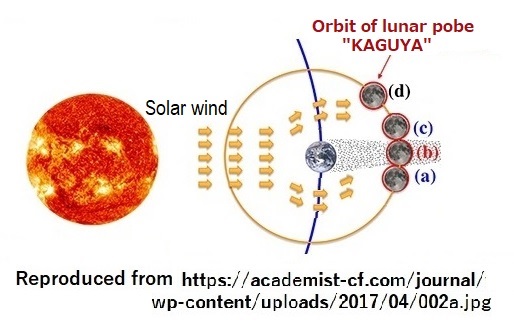Chap.4 Effects of Solar Wind on Planets and Satellites
4.1 Collision of the Earth's atmosphere with the solar wind
As many as 10 9 kg of H+ per second are emitted from the Sun.
This flow of H+ is the solar wind. the speed of the solar wind is about 300~900 km/s at
the Earth's orbit. The average free path of molecules in the terrestrial
atmosphere is about one micrometer at the surface on the ground, So, the
solar wind never reaches the surface.
Although, there is an explanation that the Earth is protected from the solar wind
by the geomagnetic field, the physical interaction of moving charged particles
is not carried out by magnetic field, but it affected by the vector potential
(A) of charged particles. magnetic field lines indicate the direction of magnetic force, and the
magnetic field lines cannot interact.
The relationship between A and magnetic flux density (B) is defined by Eq.(1).
B = rot A (1)
Here, the negative sign is set to be low when v and A are parallel.
Here, the negative sign is set to be low when v and A are parallel.
(rot) is an operation that the orbital direction of vector (A) at a minute area around a circle are added. It can be expressed in integral
form as follows. The magnetic flux (Φ) of the penetrating area is given by a line integration
of point field (A)
According to the Aharonov-Bohm effect in quantum mechanics, motioning
charged particles physically interact with each other by vector potentials
not by magnetic field lines. Dr. Akira Tonomura has proved with an electron
holography microscope that particles with electric charges such as electrons
are affected by electromagnetic potential outside solenoids that do not
have electromagnetic fields. Motioning charged particles physically interact
not with magnetic field lines, but with vector potentials.
Moving particles have a vector potential and act in the same way as electric
currents. Just as parallel currents have a magnetic coupling force, there
is a magnetic coupling between parallel charged particles. When running
in parallel, the charged particle swarm enters a magnetically low energy
state. Therefore, the solar wind reaches the edge of the solar system in
an ionic state.
When the H+ of the solar wind collides with atoms and molecules in the Earth's sky,
it ionizes those particles and generates a stream of charged particles.
It has a high speed and mass so it has a lot of momentum. As shown in Fig.10,
there are reports that high-energy oxygen (O+) is observed only when the
lunar orbiter "Kaguya" crosses the shadow part of the figure
with the Moon.

Fig. 10 Oxygen (O+) is observed only when the lunar orbiter "KAGUYA"
crosses the shadow area of the figure.
4.2 Magnetic bonding of solar wind with ions above the Earth
The H+ of the solar wind has a mass 1836 times that of electrons, has a large momentum, and it changes the motion of those particles when they collide with atoms and molecules in the upper sky of the Earth. It gives the momentum of the solar wind H+ when it collides with molecules and atoms in the atmosphere to ions, atoms, and molecules. As a result, the solar wind drives air currents in the Earth's atmosphere in the upper layers. On the other hand, the atmosphere also moves along with the rotation of the earth in the counterclockwise direction of rotation, and its speed is about that of a jet airliner near the equator.
Therefore, as shown in Fig.1, the solar wind that passes by grazing the
side of the Earth accelerates in the east side and slows down in the west,
so the Earth's atmosphere and weather is cycled in a counterclockwise direction.
As it will describ in Sec4.3, the solar wind that hits directly near the
equator in the daytime hemisphere of the Earth drives the trade winds in
the direction of clockwise rotation because it h momentum of 1.89 km/s
due to the rotation of the Sun. (last modified April 2/2023)

Fig.11 Magnetic coupling of ions in the upper sky of the Earth by the rotation
of the solar wind and the Earth
to index -4.1-